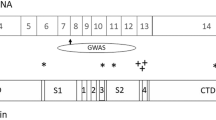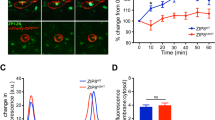Abstract
Schizophrenia is a severe psychiatric illness characterised by disturbance of thought, hallucination and delusions.1 Several studies have suggested that dysfunctions in the glutamatergic transmission are linked to the pathogenesis of schizophrenia, and in particular an excessive activation of glutamate receptors seems to be related to the disruption of neuronal ionic gradients leading to excitotoxicity.2–7 Numerous findings suggested that the kainate ionotropic glutamate receptors are primarily involved in this mechanism. Recently it has been demonstrated that the GRIK3 gene encoding for the ionotropic glutamate receptor kainate 3 contains a functional polymorphism (T928G) leading to the substitution of a serine with an alanine in position 310 of the protein sequence.8–11 We performed an association study between the ser310ala GRIK3polymorphism and schizophrenia in a sample of 99 schizophrenic patients and 116 controls. We found a significant difference in the genotype distribution and in particular considering the ala allele as dominant (P = 0.0105, odds ratio (OR) 2.031, 95% confidence interval (CI) 1.177–3.504). This finding suggests a potential role for GRIK3 for susceptibility to schizophrenia.
This is a preview of subscription content, access via your institution
Access options
Subscribe to this journal
Receive 12 print issues and online access
$259.00 per year
only $21.58 per issue
Buy this article
- Purchase on Springer Link
- Instant access to full article PDF
Prices may be subject to local taxes which are calculated during checkout
Similar content being viewed by others
References
Kendler KS The genetics of schizophrenia: an overview. In: Tsuang MT, Simpson JC (eds) Handbook of Schizophrenia, Volume 3, Nosology, Epidemiology and Genetics of Schizophrenia Elsevier: Amsterdam 1988 437 462
Coyle JT The glutamatergic dysfunction hypothesis for schizophrenia Harv Rev Psychiatry 1996 3 241 253
Dingledine R Borges K Bowie D Traynelis SF The glutamate receptor ion channels Pharmacol Rev 1999 51 7 61
Heckers S Rauch SL Goff D Savage CR Schacter DL Fischman AJ et alImpaired recruitment of the hippocampus during conscious recollection in schizophrenia Nat Neurosci 1998 1 318 323
Benes FM Sorensen I Vincent SL Bird ED Sathi M Increased density of glutamate-immunoreactive vertical processes in superficial laminae in cingulate cortex of schizophrenic brain Cereb Cortex 1992 2 503 512
Benes FM Emerging principles of altered neural circuitry in schizophrenia Brain Res Brain Res Rev 2000 31 251 269
Lipton SA Rosenberg PA Excitatory amino acids as a final common pathway for neurologic disorders N Engl J Med 1994 330 613 622
Schiffer HH Swanson GT Masliah E Heinemann F Unequal expression of allelic kainate receptor GluR7 mRNAs in human brains J Neurosci 2000 20 9025 9033
Meador-Woodruff JH Davis KL Haroutunian V Abnormal kainate receptor expression in prefrontal cortex in schizophrenia Neuropsychopharmacology 2001 24 545 552
Strutz N Villmann C Thalhammer A Kizelsztein P Eisenstein M Teichberg VI et alIdentification of domains and amino acids involved in GluR7 ion channel function J Neurosci 2001 21 401 411
Nutt SL Hoo KH Rampersad V Deverill RM Elliott CE Fletcher EJ et alMolecular characterization of the human EAA5 (GluR7) receptor: a high-affinity kainate receptor with novel potential RNA editing sites Receptors Channels 1994 2 315 326
Guruprasad K Reddy BV Pandit MW Correlation between stability of a protein and its dipeptide composition: a novel approach for predicting in vivo stability of a protein from its primary sequence Protein Eng 1990 4 155 161
Krupp JJ Vissel B Heinemann SF Westbrook GL N-terminal domains in the NR2 subunit control desensitization of NMDA receptors Neuron 1998 20 317 327
Armstrong N Sun Y Chen GQ Gouaux E Structure of a glutamate-receptor ligand-binding core in complex with kainate Nature 1998 395 913 917
Thalhammer A Morth T Strutz N Hollmann M A desensitization-inhibiting mutation in the glutamate binding site of rat alpha-amino-3-hydroxy-5-methyl-4-isoxazole propionic acid receptor subunits is dominant in heteromultimeric complexes Neurosci Lett 1999 277 161 164
Acknowledgements
This research was supported by a grant from the Italian Ministry of Health and the Cariplo Foundation.
Author information
Authors and Affiliations
Corresponding author
Rights and permissions
About this article
Cite this article
Begni, S., Popoli, M., Moraschi, S. et al. Association between the ionotropic glutamate receptor kainate 3 (GRIK3) ser310ala polymorphism and schizophrenia. Mol Psychiatry 7, 416–418 (2002). https://doi.org/10.1038/sj.mp.4000987
Received:
Revised:
Accepted:
Published:
Issue Date:
DOI: https://doi.org/10.1038/sj.mp.4000987
Keywords
This article is cited by
-
Association of Existing and New Candidate Genes for Anxiety, Depression and Personality Traits in Older People
Behavior Genetics (2010)
-
Glutamatergic abnormalities of the thalamus in schizophrenia: a systematic review
Journal of Neural Transmission (2008)
-
Ionotropic glutamate receptor gene GRIK3 SER310ALA functional polymorphism is related to delirium tremens in alcoholics
The Pharmacogenomics Journal (2006)
-
Kainate receptors
Cell and Tissue Research (2006)
-
Association study of polymorphisms in the excitatory amino acid transporter 2 gene (SLC1A2) with schizophrenia
BMC Psychiatry (2004)



